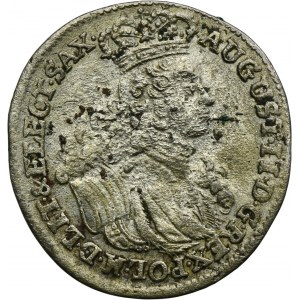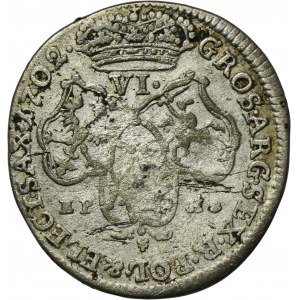A rarer and sought-after denomination of Augustus II the Strong, with the initials EPH of mincmaster Ernst Peter Hecht on the reverse.
The first vintage of August II's sixpences, minted outside Poland without the approval of the Sejm and Senate.
Tadeusz Kalkowski wrote about it, thus: "not looking at it and knowing that the impotent Republic would not draw any consequences from this fact, immediately in 1698 he began minting a Polish crown coin at the Leipzig mint."
Pieces with a corroded surface.
During the reign of Augustus the Strong, the mints of the Republic were not put into operation. In the strict sense of the word, no Polish or Lithuanian coins were minted at that time. From the point of view of the applicable law, the Leipzig issues belonged to the Saxon mint. Nevertheless, due to the Polish denominations and the Polish name of the king - August II, and not Frederick Augustus as on Saxon coins - some of the coins in this group are included in the Polish mint. These include sixpences, orts, thalers half-ducats and ducats. In addition, the Moscow mint issued Lithuanian sixpences, while the Gdansk mint issued ducats, two-ducats and shekels. A significant area of mint production during the reign of Augustus the Strong is also occupied by commemorative coins, tokens, as well as private issues.
The crown sixpences of Augustus II the Strong were pressed at the Leipzig mint in 1698 (trial issue), 1702, 1704, 1706. They belong to the Polish mint de facto, but not de jure (due to the lack of parliamentary approval). Lithuanian sixpences, on the other hand, date from 1706-1707. Like the Crown sixpences, they were stamped on a cylindrical minting machine. Not in Leipzig, however, but in Moscow - at the Admiralty Mint. They are decorated with the initials of the then Lithuanian treasurer Ludvik Konstantin Pociej "L - P" and his coat of arms Waga. Lithuanian sixpences were stamped from low-grade silver. According to today's estimates, they contained only less than 50% of the pure bullion assumed for sixpacks by the 1658 ordinance (1.305 g), or about 0.6-0.7 g of silver. The purpose of the Moscow issues was to pay the army of the Saxon party stationed in Lithuania. In 1707, however, the partisans of Stanislaw Leszczynski gained the upper hand in Lithuania, and Louis Pociej's sixpences were called out of circulation, causing losses to their owners. The initials "L - P" of the treasurer began to be mockingly translated as "the people cry". The general iconographic scheme of the Crown and Lithuanian sixpences is similar. The obverse of the coins features a portrait of the monarch and an obverse inscription with the Polish spelling of the king's name - August II, rather than Frederick August I (which Wettin used as Elector of Saxony). On the reverse, inside the obverse inscription, the denomination "VI", the shields of the coats of arms of Poland, Lithuania Saxony and the Wettins, and the initials "EP - H" of Ernest Piotr Hecht, mincmaster of the Leipzig mint (on crown sixpences) or the initials "L - P" and the coat of arms of the Lithuanian treasurer Waga (on Lithuanian sixpences) were shown under the crown.









